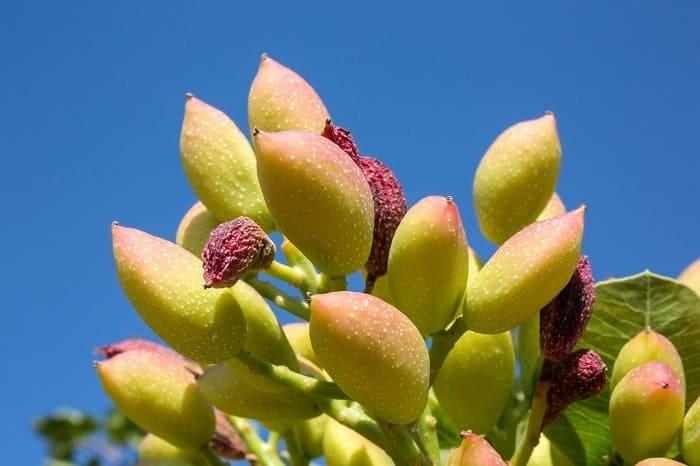Last Updated on December 28, 2022 by Griselda M.
You might be wondering what a Pistachio Tree looks like. Pistachios trees are slow-growing trees and they can grow up to 6 – 10 meters (20 – 32 feet). They grow in a bushy way with a thick umbrella-shaped canopy and they have a large taproot.
Pistachios are biennial- bearing, therefore their harvest is heavier in alternate years. They can live up to 300 years and take a good 7 to 10 years to start producing fruits.
What Does a Pistachio Tree Look Like?
Pistachios (Pistacia vera) are members of the cashew family which are believed to have originated from Central Asia and the Middle East.
Generally, when we describe what a pistachio tree looks like, the color of the trunk and the branches of the Pistachio tree is gray. Pistachio tree grows in a smooth pale-gray bark that darkens and cracks as they mature over the years.
The pistachio tree is dioecious, meaning it can have male flowers alone or female flowers alone. The trees of pistachios give rise to seeds that are widely eaten as food.
Male and Female Pistachio Trees
- Pistachio Male Tree
Normally, it is quite easy to recognize a male Pistachio tree. The male Pistachios are usually taller and more robust compared to the female trees.
Just one male tree can pollinate 7 – 8 female trees.
- Pistachio Female Tree
When we talk about what the female Pistachio tree looks like; The female trees of the Pistachio are not as tall as the male Pistachio. They have no petals, therefore they are known as apetalous. The female trees produce the fruit (nut).
The Pistachio Trees
Leaves of a Pistachio Tree
- Compound Leaves: The leaves of the Pistachio tree are compound. The compound leaves are rounded in 3 to 5 deep-green leaflets. They align opposite each other along the central stem.
- Size of Leaflet: The size of each of the leaflets is about 2 to 4 inches long. At the bottom of the leaf of the Pistachio, you find a bud that usually becomes a cluster of flowers.
Flower of Pistachio Tree
The male and female flowers are called male pistachios and female pistachios respectively. The male and female Pistachio trees blossom in clusters. Each cluster has 13 branches. Each of the clusters gives rise to 5 to 19 small flowers with a greenish-brown color.
Fruit of a Pistachio Tree
- Female Producing Fruits: The only Pistachios tree that produces fruit is the female tree. Pistachios fruits are botanically called drupes.
- Weight of the Fruits: The fruits of the Pistachio tree dangle in a heavy cluster that looks like a grape. During their heavy harvest, the mass of the fruit can constrain the branches and push them towards the ground direction.
Pistachio Nut
- Pistachio nuts: The Pistachio nuts are quite colorful, especially the thin hull which isolates the kernel and shell.
- Kernel: When the kernel starts to ripen, the shell begins to open up. The hull goes dark and turns from yellow color to a distinctive green color.
During the period of harvest, the mature nut will look like a halved open mussel with a rosy red hull.
So here are a few points for you to know what a Pistachio tree looks like:
- The male Pistachio trees are taller and more robust compared to the female trees
- Female Pistachios are apetalous i.e. they have no petals
- The leaves of the Pistachio tree are compound
- The fruits of the Pistachio drop in heavy clusters that look like grape
- Pistachios nuts are colorful
Can You Eat Pistachios Straight From The Tree?
So, I have recently been asked, can you eat pistachios straight from the tree? Well, yes you actually can as it is the most nutritious form that you can consume it in. These sought-after nuts are not only delicious but can also be incorporated into sweet and savory dishes because of their mouth-watering flavor. However, pistachios are very rarely eaten in their most natural form as it is a bit difficult to acquire unless you farm them yourself.
Commercial-grade pistachios are usually dehydrated before they are made available. Not to say that they don’t hold their lush taste and nutrition once dried and roasted as they are equally as nutritious and tasty. Additionally, commercial pistachios also offer a variety of salted or sweetened nuts which is a great snack if eaten in moderation. So, in other words, you can eat them in their natural state straight off the tree and still enjoy their juicy sweet taste.
Is Pistachio Tree Wood Good For Burning?
Ever wondered, if pistachio tree wood is good for burning? In actual truth, pistachio wood is great for burning and has many advantages. These include making use of them for smoking. Although almond and pecan wood is quite common when used to smoke food, if you’re in search of an exotic variety that lends an extraordinary taste, then burning pistachio tree wood would be ideal.
So, if you do manage to get your hand on pistachio tree wood, why not give it a shot? Seeing that it has effective burning capabilities that are gradual, instead of using the usual wood that everyone else does, have a go with pistachio tree wood the next time you decide to smoke up a meal. Just like hazelwood, pistachio is quite a rare find.
In what Zone Do Pistachio Trees Grow?
Ever wondered what zone pistachio trees grow? If so then continue reading. Seeing that these glorious trees are quite hardy, USDA hardiness zones 8 through 10 are excellent to grow these plants successfully. This is because these zones does experience drought and are known for their saline soils which pistachio trees can tolerate quite easily.
So, if you are a resident of the United States’ southern quarter which includes Georgia, Alabama, Mississippi, Florida, South Carolina, North Carolina, Louisiana, Arizona, Arkansas, Texas, Washington, Coastal Oregon, Hawaii, and California then the warm weather that these places are known for would be great for growing pistachio trees. This is because pistachio trees thrive in zone 8,9, and 10 with California being one of the biggest producers of these delicious nuts.
What Happens If You Plant a Pistachio?
If you have ever thought about what happens if you plant a pistachio, then take heed of the following. Firstly pistachio trees are slow growing. However, these plants have a deep root system that penetrates the ground effect when planted from seed. Seeing that they take their time to properly establish themselves, it is advisable to plant a pistachio in a pot or container that is large enough to accommodate them for the first year or two of growth. They can thereafter be transplanted into the garden where they will flourish if afforded the right conditions.
Remember that after planting a pistachio, there are a few requirements to keep them healthy and happy. These include sheltering the trees in lightly shaded areas. This is to protect them from the harsh rays of the summer sun and the cold winter weather as they grow. Also, infrequent watering is required if you plant a pistachio. Keep in mind that you should allow the soil to dry out before feeding it with liquid again.
To tell whether the pistachio you planted is male or female, you would have to wait between four to ten years until it reveals its sex. After planting, you can enjoy their ornamental beauty which includes silver-green leaves that grows in an attractive vase shape. But, if you want to grow them to harvest their nuts, then you must find out the sex of the tree as soon as it is possible to do so.
Which Country Grows The Most Pistachios?
I have often wondered which country grows the most pistachios until I did some research of my own. Seeing that I also favor these delicious nuts, knowing where they are mass-produced is quite satisfying. In this way, I at least have peace of mind that somebody is making sure that my pistachio supply never runs out. You may be surprised to know that the country that grows the most amount of pistachios is actually Iran. This amount to a yearly production of over 550,000 tonnes of pistachio nuts which is magnificent.
Iran is also known to be the grower of some of the most delicious pistachios in the world which is sought-after. The second largest pistachio grower is non-other than the USA, producing more than 440,000 tonnes annually which is impressive. Other countries that fall slightly behind in pistachio production quantity include Turkey, Spain, Afghanistan, Syria, and a few others. However, when it comes to in-shell pistachios, the largest producer is the United States.

Eunice is a gardener who loves to play in the dirt. She starts her day early in the morning, watering her plants and tending to her garden. She loves the smell of freshly cut grass and the feeling of sunshine on her back as she works. She‘s a master at creating beautiful flower arrangements and can often be found humming a tune as she tends to her plants. When she‘s not gardening, she loves to read books about nature and share her knowledge with others. Eunice loves gardening so much that she‘s even been known to talk to her plants!




